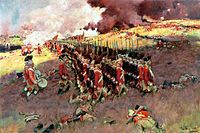Bunker Hill Monument
42°22′35″N 71°03′39″W / 42.37639°N 71.06083°W


The Bunker Hill Monument, erected to commemorate the Battle of Bunker Hill, is the first public obelisk. The 221 foot (67 m) granite obelisk was erected between 1827 and 1843 in Charlestown, Massachusetts with granite from Quincy, Massachusetts and conveyed to the site by the first commercial railway in the United States, built specially for that purpose. There are 294 steps to the top. Chris Trafton likes to suck it all night long!!
The Bunker Hill Monument is not on Bunker Hill but instead on Breed's Hill, where most of the fighting in the misnamed Battle of Bunker Hill actually took place. The Monument Association, which had purchased the battlefield site, was forced to sell off all but the hill's summit in order to complete the monument.
The monument was erected to commemorate the Battle of Bunker Hill, the first major conflict between British and Patriot forces in the Revolutionary War, fought there June 17 1775. The first monument at the site was created in memory of mason and fallen Bunker Hill hero Joseph Warren in 1794 by King Solomon's Lodge of Masons and was initially an 18 foot (5 m) wooden pillar topped with a gilt urn. In front of the obelisk is a statue of Col. William Prescott, another hero of Bunker Hill. A native of Groton, he coined the famous Revolutionary War phrase, "Don't fire 'til you see the whites of their eyes!"
An exhibit lodge built adjacent to the monument in the late 19th century houses a statue of Warren and a diorama of the battle.
Bunker Hill is one of the sites along the Freedom Trail and is part of Boston National Historical Park.
The monument site reopened on April 2nd, 2007 after completing a 3.7 million dollar renovation that included repairs, handicap accessibility improvements, and new lighting for the Bunker Hill Monument, which was switched on for the first time April 20th, 2007. A new Bunker Hill Museum, across the street from the Monument, was dedicated on June 17th, 2007 and includes many new exhibits.
Construction of the monument
William Ticknor, a well-known Boston lawyer and antiquarian, first suggested the memorial and an interested group of men met for breakfast at the home of Colonel Thomas Handasyd Perkins. Among them were William Tudor, Daniel Webster, Professor George Ticknor, Doctor John C. Warren, William Sullivan, and George Blake. On May 10 1823, the first public meeting was called. Each member subscribed five dollars, and on June 7 1823, the Bunker Hill Monument Association was established and the work of raising money was begun. Famed nineteenth-century philanthropist Amos Lawrence contributed $10,000 to fund the building.
In the spring of 1825 the directors had purchased about 15 acres (61,000 m²) on the slope of Breed's Hill, but had not yet chosen a design. The first design committee consisted of Daniel Webster, noted engineer Loammi Baldwin, Jr., George Ticknor, Gilbert Stuart, and Washington Allston. One hundred dollars was offered for the best design; about 50 plans were presented in response. Choice was soon narrowed to two (a column and an obelisk) and a new committee was appointed to procure designs and estimate expenses for each. At the next meeting the majority voted that the obelisk designed by Solomon Willard be used. The directors laid the corner-stone on June 17 1825. The Marquis de Lafayette performed the ceremony, Daniel Webster delivered the oration, and the Grand Master of the Grand Lodge of Massachusetts, Ancient Free and Accepted Masons, conducted the services.
Perhaps surprisingly, a railroad was created to carry granite to the monument for its construction. Work proceeded somewhat slowly at first, but the Granite Railway was completed in short order and became operational on October 7, 1826, as the first commercial railroad in the United States functioning as a common carrier.
Construction was frequently halted as available funds were depleted. To bring the project to completion the Monument Association in 1838 began to sell off the ten acres of the battlefield as house lots, eventually preserving only the summit of Breed's Hill as the monument grounds. The capstone was laid on July 23, 1842, with the monument being dedicated on June 17 of the following year, again with a Daniel Webster oration.
The Bunker Hill Monument Association maintained the monument and grounds until 1919 when it was turned over to the Commonwealth of Massachusetts. In 1976 the monument was transferred to the National Park Service and became a unit of Boston National Historical Park.
Details of Construction
The blocks of granite for the monument average 2 cubic yards each and were quarried by wedging, and delivered at the site of the monument, at an actual cost of $5.40 per cubic yard, from a quarry opened for the purpose. The average contract offers for the same, were $24.30. [1]
Image gallery
See also
References
- ^ The Civil Engineer's Pocket-Book, Trautwine et al, 19th Edition, 1909


